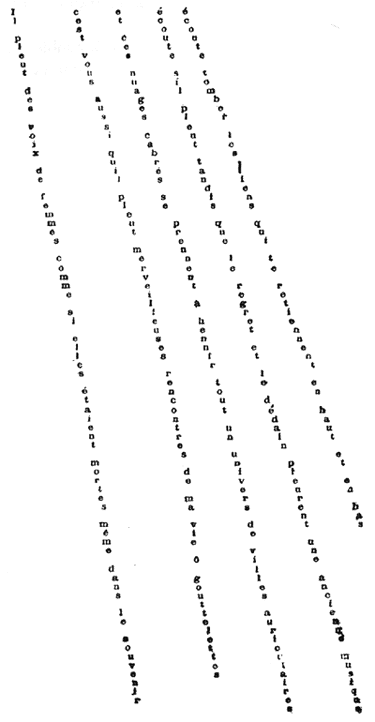Winged Type
The poem is something to look at, as well as to read and recite.
The poem appeals to the eye. It has a shapely dimension and thus relates to the plastic arts, especially painting. The poem is something to look at as well as recite. Think, for example, of e.e. cummings’s typographical experiments or of John Hollander’s inventive poems of visual display in Types of Shape or of Marianne Moore’s symmetrical stanzas that look as if they were written on a typewriter. Moore’s poems are written in crystalline syllabics. It is hard to imagine them handwritten. The words look as if they were scoured and dipped in acid, broken down into particles, into constituent parts, and then reconstructed, cleansed and molded, on the page. The desire to bring together both literary and visual impulses in a shaped poem is apparently very ancient, as Dick Higgins demonstrates in his encyclopedic history and anthology Pattern Poetry: Guide to an Unknown Literature. Higgins points to a bewildering variety of early sources: pattern poems in Greek, Latin, and Hebrew, and in most of the modern European literatures; Chinese pattern texts; Sanskrit citra kavyas and other Indic texts. There are six surviving pattern poems from Hellenistic Greece: two shaped as altars, and one each as an egg, a syrinx, an ax, and a pair of wings. (These may have served a magical or talismanic function since they were religious expressions.) These in turn became the model for the 110 pre-1750 British pattern poems that survive. It is this tradition, for example, that stands behind George Herbert’s two masterpieces from The Temple (1633), “The Altar” and “Easter Wings,” where the lines, of varying lengths, give the poems a visual shape suggesting an altar and Easter wings respectively. The lines fit the form exactly and the emotional curve of the poem matches the articulation of the shape on the page. I adore Guillaume Apollinaire’s Calligrammes, a term he coined early in the century for the kind of shaped poem he believed he had invented for modernism (“Moi aussi je suis peintre,” he wrote), but in truth he was developing the latest avant-garde manifestation of what in Latin poetry was called carmen figuratum (figured poems).
Here is Apollinaire’s poem “Il Pleut,” first in the original and then in Roger Shattuck’s linear translation:
Il Pleut

It’s Raining
It’s raining women’s voices as if they had died even in memory
And it’s raining you as well marvellous encounters of my life O little
drops
Those rearing clouds begin to neigh a whole universe of auricular cities
Listen if it rains while regret and disdain weep to an ancient music
Listen to the bonds fall off which hold you above and below
The slanting lines of Apollinaire’s poem create the sensation of rain running downward across a windowpane. Graphic form and verbal music come together as each long vertical line becomes a rhythmic unit of meaning. The sound of the unpunctuated lines in French creates an incantatory murmuring that evokes the sadness and melancholy of a rainy day in Paris. And yet, as Anne Hyde Greet and S. I. Lockerbie point out in their acute commentary on Calligrammes there is a rich ambiguity of feeling in this poem that goes beyond a simple Verlainean melancholy. Whereas the first line associates the rain with a vanished happiness, the second and third lines associate it with the wide encounters—the opening outward—of the modern world. “Trickling raindrops may be expressive of sadness,” they write, “but in the way they spread down and over the windowpane there is also a sense of adventure and exploration of space.” Apollinaire thus concretizes in the light undulating lines the sense of an old life that is sadly passing even as a fresh world is opening up.
What especially compels me about the pictorial lyric, the lyrical emblem, is how the poem displays itself as a metaphor. It says, I am something else. The viewer interacts with the shape; the reader experiences the precise relationship between the subject and the object, the content and the form. The writer puts the rain down on the page, the reader lets it fall.
Poet and author Edward Hirsch has built a reputation as an attentive and elegant writer and reader of poetry. Over the course of many collections of poetry and criticism, and the long-running “Poet’s Choice” column in the Washington Post, Hirsch has transformed the quotidian into poetry in his own work, as well as demonstrated his adeptness at explicating the nuances and shades of feeling, tradition...


